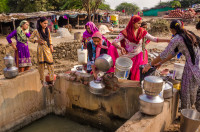Opinion
Drink camel milk!
I never thought the day would come when I would recommend drinking milk. But it has and I am recommending people to drink camel milk.
I never thought the day would come when I would recommend drinking milk. But it has and I am recommending people to drink camel milk. Recently the Food Safety & Standards Authority of India (FSSAI) put camel milk on its list of animal products that can be marketed for human consumption. This decision has come as a result of sustained lobbying by Sahjeevan, the NGO that is working to save camels and pastoral breeders. However, since FSSAI is, after all, ruled by government bureaucracy, they cannot do anything without making major mistakes. So some genius (read idiot) in the FSSAI has written that standard camel milk has to have 3.0 percent fat. This is unrealistic, as camels in India are open grazed and their milk has 1.5 to 2.5 percent fat. The FSSAI has been made aware of this discrepancy and has agreed to revise the standards, after a study by a credible agency has sampled fat in Indian camel milk.
Cruelty-free
Drink camel milk for three reasons. One: it will save the camels. Camels are in a steep decline in India. In 2012 there were 4 lakh camels in the country—down from 10 lakh in 2008. Now they are less than a lakh. They are found in five states: Rajasthan, Gujarat, Haryana, UP and Bihar, while 80 percent are found in Rajasthan, largely bred by the Raika community herders. There are nine recognised breeds of camels in India, of which seven are found in Rajasthan. There are two crore camels in the world—and India is the only country where they are being decimated, because keeping them has become increasingly unviable for pastoralists. Their traditional way of life has
been attacked by disappearing grazing lands, mechanised farming, and parasitic disease. The Raikas also find themselves struggling to survive in the face of active hostility towards their migratory traditions.
In Rajasthan the number of Raika herders has dropped more than 70 percent since the 1990s. The number of camels has fallen so drastically in the past 30 years, that it prompted the Rajasthan government to declare it as the state animal in 2014, hoping to increase protection for the animal.
Because draught animals are being replaced by machinery, camels are increasingly being sold illegally for meat. Every day a 100 or so are brought out of Rajasthan—even when the law there says that no camels can be taken outside the state—and cut in Mewat, Baghpat, Meerut, or sent to Bangladesh. If we would drink camel milk then the herders could earn thousands every month and they would have an incentive to keep them.
The second reason to drink camel milk: it cannot be won in the same cruel fashion as cow and buffalo milk. Camels are free grazing. They cannot be locked up and their male children cannot be sold to the butchers, because then the mothers simply won’t give milk.
Female camels’ thirteen-month gestation period must conclude in a live birth followed by suckling, else the female camel will stop producing milk. Unlike a dairy cow, which is parted from her calf when it is born and then gives milk for six to nine months, a camel can share her milk with the farmer and her calf for twelve to eighteen months. Therefore, pastoral farmers will be the main suppliers.
Low fat superfood
The third pro camel milk argument is that it is much better for you than cow or buffalo milk. It is a superfood for diabetics. Camel milk contains 52 units of insulin per litre, which is 60 percent of the average necessary external insulin administration for type 1 diabetics, and helps to regulate blood sugar levels, giving your body the insulin intake it needs in the most natural form. A study conducted on 24 type 1 diabetes patients, who consumed camel milk alongside a standardised diet and exercise, concluded “there was a significant improvement in the microalbuminuria after receiving camel milk for six months. A significant reduction in the mean dose of insulin for obtaining glycemic control was achieved.” There is also evidence that camel milk helps with diabetic nephropathy.
One of the major complaints which diabetics have is that their pancreases do not function efficiently enough to process sugar into its energy components. Camel milk improves the pancreatic function of the body, enabling the breaking down and absorption of blood sugar. A study conducted over three months compared the effects of camel and cow milk on a group of diabetic and non-diabetic men. The diabetics who were given camel’s milk showed a decrease in blood sugar levels when fasting and in blood glucose levels after eating. Their average blood sugar levels were also reduced.
One of the serious complications of diabetes is delayed wound healing and the consequent high chances of bacterial infections. A study demonstrated that camel whey proteins expedite the healing of diabetic wounds, by enhancing the immune response of wounded tissue cells.
Nutritionally, camel’s milk is lower in total fat, saturated fat, but equal to cow’s milk in protein. It has 10 times more iron and five times more vitamin C than cow’s milk. One cup of camel milk contains approximately 107 calories and 293 milligrams of calcium (more than any other milk) besides 5.4 grams of proteins. It has a higher amount of magnesium, iron, phosphorus, potassium, sodium and copper, Vitamin C, A, D, B1, B2 & E. It contains immunity boosting lysozome and lactoferrin (antimicrobial agents) and less fat, whey protein, lactose and zinc. Cholesterol in camel milk is lower than in cow or goat milk. It is considered safe for children allergic to bovine milk.
Supply and demand
Is camel milk something new? Camel milk production totals more than 1.8 million tons per year globally, with Somalia making the most. In 2006, in view of its medical value, the UN declared camel milk as a superfood.
But camels, because they have not been tampered with genetically and given hormones and antibiotics as cows and buffaloes have been, produce only four to five litres of milk a day—compared to 40 litres that cows are made to produce. So there is less of it, and it is more expensive. The upside is that it is totally organic, and you do not get deadly poisons in it like oxytocin—which every single litre of cow/buffalo milk has in India and which gives tuberculosis, cancer and other diseases. Where can you buy camel milk? You can get it from the Bikaner based National Research Centre on Camels. The Kumbhalgarh Camel Dairy, based at the LPPS Camel Conservation Centre at Sadri, Rajasthan.
You can order it online from Camelicious, a company in Dubai. Or you can ask your local supermarket to get it. If there is demand, there will be supply.
To join the animal welfare movement contact [email protected], www.peopleforanimalsindia.org




 18.12°C Kathmandu
18.12°C Kathmandu









